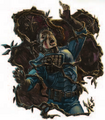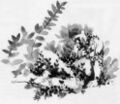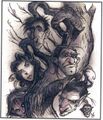Carnivorous Plant: Difference between revisions
No edit summary |
|||
| Line 116: | Line 116: | ||
</gallery> | </gallery> | ||
*'''[[Yellow Musk Creeper]]''': A pretty creeping vine with beautiful yellow flowers. It lures victims in with its sweet scent, and then plants seeds in their heads, which consume the host's brain and then hijack the body as a [[zombie]] they pilot to find a new place to grow. | |||
<gallery> | <gallery> | ||
Yellow musk creeper 1.jpg | Yellow musk creeper 1.jpg | ||
Revision as of 17:27, 24 October 2022
Carnivorous plants are plants that derive at least some of their nutrients from trapping and killing animals or microbes, rather than through photosynthesis. Fiction is rife with examples of man-eating plants, especially RPGs, given how easily they fit into the role of Gotcha Monster.
In Dungeons & Dragons we got a lot of these in the second Monster Manual. Mostly Neutral Evil.
IRL, carnivorous plants live in nutrient- and mineral-poor environments like bogs and make up the difference with insects they catch (and the occasional rodent, for some of the larger pitcher plants). As such, adding a few carnivorous plant monsters would be a good fit to any swamp environment. The means in which they capture and digest prey are quite interesting. For more information on the subject, ZeFrank as you covered
Dungeons & Dragons
- Assassin Vine or Choke Creeper: A predatory vine-like plant that drapes itself across tree branches, and attempts to strangle any animal that gets within range.
- Black Willow
- Bloodroot: Roots that stick out of the sides of underground passageways. When something passes by them, they grab it, inject it with a blood-thinning poison, and suck out all its liquids.
- Bloodthorn: Yet another bloodsucking vine. This one is native to the Lower Planes.
- Bohun Tree: The fruits of this tree resemble giant grapes, but if bruised or damaged in any way, they release a soporific vapor that has a 10% chance of paralyzing your lungs and killing you. The tree will deliberately burst its own fruit if attacked. It is also covered in thorns that can be fired off of it as projectiles. It can also send its roots up through the ground to grab you. Appeared in Dragon #89.
- Boneleaf: An aberration that resembles a plant. It is intelligent and can use illusions to lure prey. All boneleaves in an area are actually parts of a single organism so what one learns, all boneleaves nearby also learn.
- Crawling Ivy: Prehensile ivy that has tiny pores all over its leaves that it uses to suck out your blood.
- Death's Head Tree: Looks like a weeping willow with animate heads of humans and demihumans as fruit. The heads softly call for help to lure prey. In combat, the heads detach from the tree and float (not magically, but via "gasses"), spit needle-like seeds, and bite. These seeds embed into victims' skin and then germinate and grow into a new tree. A seed that lands on the ground can also germinate if exposed to blood. The whole thing is immune to fire and resistant to magic.
An alternate version appears in Dragon Magazine #292, where the fruits are now skulls, and instead of floating, they are thrown by the tree like grenades, bursting on impact with seed shrapnel.
- Giant Sundew: Looks nothing like a sundew. It can pull up its roots and drag itself around with its prehensile sticky tendrils.
- Hangman Tree: A tree with noose-like vines that it uses to lift prey up into its "mouth". Can move at 2 feet per hour.
- Ironmaw: A carnivorous tree that can disguise itself as any other type of tree. Native to the Outer Planes.
- Kampfult: A lot like a roper, but it's disguised as a tree stump instead of a rock outcrop. Apparently its body is like a long length of rope, and it can unravel itself to act much more like an assassin vine (above).
- Razorvine: The most common weed in Sigil and the Outer Planes. Its vines are so sharp that anyone who falls into a patch is likely to bleed to death. While dangerous, it is not normally carnivorous, but exposure to certain spells can awaken a dim intelligence in it, after which it will begin absorbing any blood spilled on it. They can even communicate by writing words with the blood, and can be trained to answer questions about what they have seen in exchange for more blood.
- Singing Tree: This arboreal siren's song compels animals to rest under its shade. It then detaches leaves that land on the prey, suck 1 HP of blood per leaf, then rise back up and reconnect to the tree.
- Thornslinger: Can shoot out a near infinite supply of thorns. Its whole body is super sticky, trapping anyone who touches it. The thornslingers in the Ravenloft adventure When Black Roses Bloom are retconned to be much more like Vampires Roses, turning from white to black by feeding on blood.
- Tri-Flower Frond: A plant with three differently colored flowers that each do something different.
- Twilight Bloom: A sweet-smelling plant with purple flowers that drips a poison that can kill instantly on people that walk under it.
- Vampire Cactus: Resembles an agave plant with a yellow bloom spike upon which a single red flower grows. Each leaf ends in a large needle that shoots out at prey, remaining attached by a hollow, rubbery thread. Once a needle is embedded in the victim, the plant drains 1d3 HP of blood per round. Needles can be reeled in and fired again.
- Vampire Moss: Moss that remotely steals 1 HP per round from any creature that gets within 10 feet.
- Vampire Rose or Bloodrose (or, er, Jupiter Blood Sucker): White roses that turn red after soaking up a creature's blood. They remain motionless until an animal wanders into the center of their patch, then tear it open with their thorny tendrils.
- Yellow Musk Creeper: A pretty creeping vine with beautiful yellow flowers. It lures victims in with its sweet scent, and then plants seeds in their heads, which consume the host's brain and then hijack the body as a zombie they pilot to find a new place to grow.
































